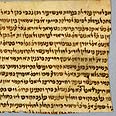
US rabbi's books tied to Holocaust survivors
Two pieces of rare Talmud passages distributed to Holocaust survivors at WWII's end surface in Ohio; texts helped survivors rebuild spiritual life
As Holocaust survivors languished in displacement camps around Europe at the close of World War II, the US Army gave them some of their first tangible connections to their faith since before the war: passages from the Talmud.
Now two pieces of that limited printing have ended up in the hands of an Ohio rabbi, who used one in a pre-Passover service on Friday as historians pondered their rarity and debated their impact on history.
The two tractates, or passages that help make up a collection of religious and civil law known as the Talmud, are dated 1946 and belong to a limited number of such books the US Army authorized for publication.
They were created to help displaced Holocaust survivors who had their belongings, including religious materials, destroyed during World War II. Some experts say it's unclear how many copies were printed or how many exist today, but they all agree they're a collector's item that offer a glimpse into a unique printing agreement that US armed forces had following the war.
Rabbi Areyah Kaltmann, who runs the Lori Schottenstein Chabad Center in Columbus, snagged the two tractates from a New York City auction house for $600 on March 21. The Australian native said he owns several other tractates published in later years.
"I like to collect them," the 45-year-old said. "I like these things because they're meaningful."
The Talmud is a compilation of Jewish oral law and stories about 1,500 years old. Historians and archivists say it's also one of the few religious materials the US Army ever authorized for publication.
Talmud helped survivors recover
Abby Meyer, who works at New York-based Kestenbaum and Company, which specializes in selling Judaic items and sold the books to Kaltmann, said the auction house has only sold a handful of single tractates in its more than 20 years in business.
Lenore Bell, library director at the United States Holocaust Memorial Museum in Washington, said the books are probably the first two tractates of the Talmud to be produced in Germany with the authorization of the US Army after the war.
"What's significant is the publication itself and how important it was to provide these texts to help rebuild the religious lives of survivors," she said. "And the US Army contributed to that process."
The two tractates offer guidance on marriage and vows, and are the only two tractates published in 1946 because they were the most complete copies available at the time. They were published by the Va'ad Hatzalah – an emergency Orthodox rescue group which helped displaced rabbis – and the Rabbinical Council, a group made up entirely of US chaplains who were Jewish. The Rabbinical Group was authorized to work for the US Army in Germany.
The 1946 tractates were part of a US Army effort to help distribute religious materials to displaced Holocaust survivors who had their belongings and spiritual readings destroyed during the war. Few copies of the Talmud, which can range in volume size, were immediately available after the war. But the two tractates called Kiddushin and Nedarim, which focus on marriage and vows, were distributed because they were the most accessible and preserved readings at the time. Distribution was limited, however, because of scarce materials and resources to print. But Bell said they were important printings because they got into the hands of survivors earlier than others.
Bell said these two tractates should not be confused with the more famous and complete set of tractates published between 1948 and 1950 with the help of the American Jewish Joint Distribution Committee, which provided health care and other forms of aid to displaced Holocaust survivors. The JDC, along with the Rabbinical Council, published a 19-set volume of tractates to make a full Talmud. Limited resources brought down the project's scope, and only several hundred sets were published. A full set from this period is also considered a collector's item, though individual tractates sell at auction houses for more moderate prices.
In memoriam of Toulouse victim
Menachem Rosensaft, who serves as vice president of the American Gathering of Jewish Holocaust Survivors and Their Descendants, said the full set of books were more symbolic by the time they were published because the US had relaxed its immigration laws and many displaced Jews had found permanent homes in the US and elsewhere. He called those books, also known as the Survivors' Talmud, a psychological milestone for the survivors.
"It really meant a spiritual and religious rebirth," said Rosensaft, who was born in Germany's Bergen-Belsen displaced persons camp in 1948. "It meant you had a continuation of a centuries-old tradition. It gave the survivors a tangible sense that their heritage had not been destroyed."
Kaltmann read the end of one of his tractates during a traditional ceremony before the beginning of the Passover holiday. The ceremony usually calls for only one person to recite the end of one tractate, but Kaltmann and his three sons completed the end of a tractate each in honor of Rabbi Jonathan Sandler, who was recently killed with his two sons and another young girl in Toulouse, France.
"We're trying to bring hope," he said. "We're trying to bring life and positivity to the shattered pieces we're left with."










